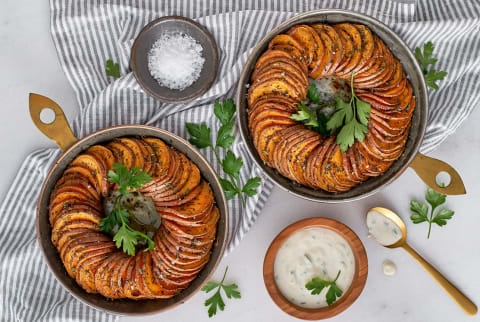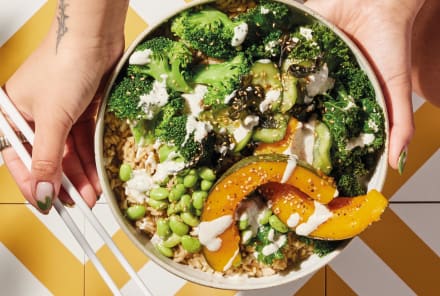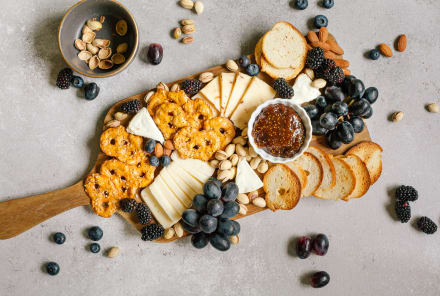Advertisement
The Healthiest Carbs For Your Blood Sugar, According To An RD


You can't bring up the word carbs without provoking a variety of urges and emotions; love, hate, craving, guilt, good, bad—the list goes on. While some people may benefit from cutting carbs out, most people can enjoy healthy carbs in moderation and benefit from the vitamins, minerals, antioxidants, and fiber they pack.
As you read this list, keep in mind that the best type and amount of carbs will differ from one person to another, depending on age, exercise level, blood sugar, medical history, hormone balance, digestive health, body composition, and overall health goals.
The timing of carbohydrate meals and snacks matters, too. You certainly don't want to eat carbs all day long, as this can interfere with your blood sugar, energy levels, and hormone balance. Instead, enjoy healthy carbs two to three times a day, especially when balanced with healthy proteins and fats.
Here's a list of the healthiest carbs with tips and suggestions for each one. If you have a specific medical issue that may warrant different types or certain restrictions, reach out to a dietitian who can customize your options:
1. Nonstarchy veggies
Let's start with the best first. Nonstarchy veggies like broccoli, cauliflower, cabbage, kale, spinach, zucchini, and asparagus all contain carbohydrates. That's surprising for many people because they envision a plate of cookies and doughnuts when they think of carbs. But vegetables contain carbs, and you can't eat a zero-carb diet if you're planning to include these nutrient-rich foods on your plate! These nonstarchy veggies are packed with fiber, water, and antioxidants, and their carbohydrate content is relatively low when you consider their volume and weight. That makes them some of the most filling and nutrient-dense foods you could eat.
If vegetables make you bloated or gassy, or if they're not part of your diet already, start with small portions first. Cooked vegetables are easier to digest and may be tolerated better. Roast or steam to preserve nutrients or incorporate them into stews and soups.
2. Winter squash and sweet potato
Sweet potatoes and winter squashes—like butternut squash, acorn squash, pumpkin, and spaghetti squash—contain very similar nutrients. They are packed with potassium, beta-carotene (a vitamin-A building block), and fiber. They also have natural sugars called polyols that lead to smoother bowel movements. If you suffer from constipation, these vegetables can offer an excellent natural laxative remedy. If you have diarrhea or loose stools, stick to ¼- to ½-cup portions.
Winter squashes are less starchy and contain fewer carbohydrates and calories compared to white potatoes, sweet potatoes, and grains. Include a variety in your diet roasted on their own or with other veggies. Puree into creamy hearty soups or add to baked goods like muffins and pancakes. Spaghetti squash is a great alternative to grain-based pasta.
3. Buckwheat
Despite having the word wheat in its name, buckwheat is a completely different plant and is 100 percent gluten-free. It packs several antioxidants, vitamins, and minerals. When compared to other grains, buckwheat—which is technically a seed—has more fiber and protein. Buckwheat can also help reduce cholesterol1 and blood pressure and lower your diabetes risk. The fiber promotes healthy digestion and improves satiety, which can potentially help you lose weight.
Buckwheat has an earthy, nutty taste, so it's great as a side dish instead of rice. If you're not sure where to start, cook some in advance and then add to salads or mix with sautéed vegetables and ground meat for a quick and easy meal. Buckwheat hot cereal is an alternative to oatmeal, and you may enjoy buckwheat soba noodles for an Asian-themed dinner as well. Note that some soba noodles are also made with wheat, so if you’re looking for gluten-free buckwheat noodles, read the label and ingredients list carefully.
4. Oat
Oats contain a fiber called beta-glucan that has been shown to lower LDL cholesterol2, reduce insulin response3, and improve beneficial gut bacteria4. Oat bran also helps relieve constipation5 and may reduce the need for laxatives. Try oat bran as a breakfast cereal cooked with water and topped with nuts and berries, or use it to replace processed flours in baked goods. Steel-cut oats and rolled oats are great options too. Avoid sweetened oatmeal preparations. Instead, make your own with cinnamon or nutmeg and add fresh fruit like chopped apples, pears, or berries.
A small note on oats: If you're sensitive to wheat or gluten, or if you have celiac disease, choose oat products that are certified gluten-free. Oats also contain a protein called avenin that has a similar structure to gluten. Some people who have celiac disease or sensitivity to gluten may react to this protein, so pay attention to any symptoms you might experience.
5. Beets
Nitrates in beets can lower blood pressure6, boost athletic performance7, and improve cognitive function8. Beetroot contains a compound called betaine that protects the liver by preventing fat from accumulating there, which is a condition called non-alcoholic fatty liver. Betaine also stimulates bile flow to aid in digestion. Beets are rich in the fiber pectin, which help you have healthy bowel movements and healthy gut flora.
You can enjoy beets raw or cooked. I especially love raw spiralized or shredded beets added to salads; you can prepare those yourself, or many health-conscious grocery stores offer them chopped or shredded in their produce section. To roast beets, prepare them with olive oil and herbs, and mix them with cooked greens as a side dish or add them on top of salads. Check out these amazing ways to enjoy beets in your everyday meals.
And don't panic if your bowel movements turn red after eating red beets; that's totally normal!
6. Beans, peas, and lentils
Beans, lentils, and peas are legumes packed with fiber, magnesium, folate, and other B vitamins. The fiber and protein help boost fullness and satiety, reduce blood sugar fluctuations, and lower cholesterol levels. Beans, peas, and lentils are part of a healthy diet that helps lower blood pressure, reduce the risk of cancers, improve digestive health, and regulate bowel movements.
Beans go great with just about anything. They are easy to throw in a soup or stew, on top of a salad for some extra fiber and protein, and, of course, make a great side dish for any meal. There are many types of beans, peas, and lentils to choose from that offer a variety of textures and flavors from different ethnic cuisines.
Some people, however, may have a hard time digesting and tolerating legumes. If you have a digestive or autoimmune disorder, it may be better to avoid them until you're able to support your gut and digestion. Consult with an integrative dietitian if that's your case.
7. Berries
Berries are packed with vitamins, minerals, polyphenols, and antioxidants that reduce inflammation and oxidative stress. They are low in sugar and carbohydrates and high in fiber, making them friendly on the keto and low-carb diets.
Which berries should you eat? All of them! Strawberries, blueberries, blackberries, raspberries, and other less common varieties! The more colors you eat, the more nutrients and different antioxidants you nourish your body with. Frozen berries are perfectly fine as they are often picked in season when their nutrient levels are at their peak.
8. Apples
Apples can reduce the risk9 for cardiovascular disease, type 2 diabetes, Alzheimer's disease, cancer, asthma, and cognitive decline. In addition to vitamins and minerals, apples contain pectin, a prebiotic fiber that promotes the growth of healthy gut bacteria. Apples also contain the antioxidant quercetin10, which helps modulate immune response and reduce asthma and histamine allergic reactions. Choose organic apples when you can as non-organic apples tend to lead The Dirty Dozen list when it comes to pesticide content.
People with irritable bowel syndrome, SIBO, or digestive discomfort may experience stomach pain, bloating, gas, or diarrhea when eating apples. This doesn't mean you should avoid them long term. Instead, try to uncover why you can't tolerate apples and correct the problem so you can enjoy this healthy fruit again.
9. Quinoa
Quinoa is high in protein and fiber, making it one of the best carbohydrates for balancing blood sugar and boosting fullness and satiety. It's a great source of magnesium, phosphorus, folate, iron, quercetin, and other antioxidants.
Rinse raw quinoa thoroughly before cooking using a fine-mesh strainer. This will wash away the natural coating that covers the seeds, called saponin, which can make quinoa taste bitter and soapy. Some of my patients report stomach upset when eating too much quinoa. If you have IBS, IBD, an autoimmune issue, or any disorder that makes your gut sensitive, be careful with quinoa. If it's not on the menu on a regular basis already, introduce it slowly.
10. Oranges
Oranges contain fiber, vitamin C, and potassium that help you maintain a healthy heart, gut, and skin. Antioxidants in oranges lower inflammation, blood pressure, the risk for cancer, and histamine allergic reactions. Eat the fruit, but avoid the juice for more fiber and less sugar.
Grate orange peel and add to salads, dressings, marinades, smoothies, and meat and vegetable dishes. The antioxidant hesperidin11 is more concentrated in the peel than 11the actual fruit. Just make sure you wash oranges thoroughly before you grate them.
11. Banana
There's no denying that bananas are probably the starchiest fruit and pack the most carbohydrates, sugars, and calories. However, they contain potassium, which helps lower blood pressure and reduce water retention. If you participate in intense workouts, bananas can help you regulate fluid and electrolyte balance. Half a banana is usually tolerated by most people with digestive disorders.
Underripe bananas are concentrated in fibers12 like pectin and resistant starch that boost beneficial gut bacteria. As bananas ripen, their fibers turn into sugars. Since our bodies don't absorb fiber, eating them before they turn too yellow may help you manage your blood sugar level, especially if you stick to half a banana and pair it with a healthy fat or protein like almond butter.
12. Dates
Dates are high in antioxidants13, fiber, and potassium. They are anti-inflammatory and may help fight against cancer. Despite their sugar content, dates are low on the glycemic index14 and may be beneficial for people with diabetes.
Dates have become a kitchen staple in recent years. If you're buying the large medjool dates, stick to one at a time. I like to stuff dates with whole pecans, almonds, or walnuts to balance out the sugar. You can blend or process dates with almond butter, chia or flaxseeds, coconut or coconut oil, or your other favorite nuts and seeds to make a high-protein snack bar. Date sugar is a natural alternative to brown sugar, and date or date paste can be added to smoothies and baked goods for natural sweetness and added fiber.
14 Sources
- https://www.cambridge.org/core/journals/journal-of-agricultural-science/article/phytochemicals-and-biofunctional-properties-of-buckwheat-a-review/B9D5817B1F650617B2BBCA01503FCEE7
- https://www.ncbi.nlm.nih.gov/pubmed/25411276
- https://www.sciencedirect.com/science/article/pii/S0271531706002454
- https://www.ncbi.nlm.nih.gov/pubmed/26511097
- https://www.ncbi.nlm.nih.gov/pubmed/18382081
- https://www.ncbi.nlm.nih.gov/pubmed/29141968
- https://www.ncbi.nlm.nih.gov/pubmed/24791915
- https://www.ncbi.nlm.nih.gov/pmc/articles/PMC4425174/
- https://www.ncbi.nlm.nih.gov/pmc/articles/PMC3183591/
- https://www.ncbi.nlm.nih.gov/pubmed/27187333
- https://www.sciencedirect.com/science/article/pii/S1658077X16300960
- https://www.ncbi.nlm.nih.gov/pubmed/23609775
- https://www.ncbi.nlm.nih.gov/pubmed/15670984
- https://www.ncbi.nlm.nih.gov/pubmed/12070575
Watch Next
Enjoy some of our favorite clips from classes
Enjoy some of our favorite clips from classes
What Is Meditation?
Mindfulness/Spirituality | Light Watkins
Box Breathing
Mindfulness/Spirituality | Gwen Dittmar
What Breathwork Can Address
Mindfulness/Spirituality | Gwen Dittmar
The 8 Limbs of Yoga - What is Asana?
Yoga | Caley Alyssa
Two Standing Postures to Open Up Tight Hips
Yoga | Caley Alyssa
How Plants Can Optimize Athletic Performance
Nutrition | Rich Roll
What to Eat Before a Workout
Nutrition | Rich Roll
How Ayurveda Helps Us Navigate Modern Life
Nutrition | Sahara Rose
Messages About Love & Relationships
Love & Relationships | Esther Perel
Love Languages
Love & Relationships | Esther Perel











